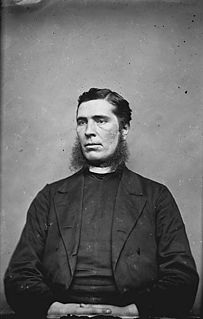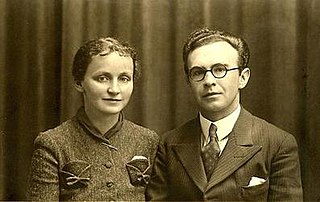Related Research Articles

Waldo Goronwy Williams was one of the leading Welsh-language poets of the 20th century. He was also a notable Christian pacifist, anti-war campaigner, and Welsh nationalist. He is often referred to by his first name only.

Daniel Silvan Evans was a Welsh clergyman, scholar and lexicographer. Educated at the Independent College in Brecon, Silvan Evans worked as a schoolmaster for five years. On marriage he conformed to the Established Church, studying at St David's College, Lampeter, where he became lecturer in Welsh. Ordained deacon in 1848 and priest the following year he served curacies at Llandegwning parish in Llŷn and from 1852 to 1862 at nearby Llangian, Caernarfonshire. In 1862 he was appointed to the living of Llanymawddwy, Merioneth.

William John Gruffydd was a Welsh scholar, poet, writer and editor, and the last Member of Parliament to represent the University of Wales seat.

Tal-y-llyn Lake,, also known as Talyllyn Lake and Llyn Myngul, is a large glacial ribbon lake in Gwynedd, North Wales. It is formed by a post-glacial massive landslip damming up the lake within the glaciated valley. The hamlet of Talyllyn lies at the west end of the lake.

Mererid Hopwood is a Welsh poet. She became in 2001 the first woman to win the bardic chair at the National Eisteddfod of Wales.
David James Jones, commonly known by his bardic name Gwenallt, was a Welsh poet, critic, and scholar, and one of the most important figures of 20th-century Welsh-language literature. He created his bardic name by transposing Alltwen, the name of the village across the river from his birthplace.
Gwynn ap Gwilym was a Welsh poet, novelist, editor and translator.
Sir Alun Talfan Davies was a Welsh judge, publisher and Liberal politician.

Y Fro Gymraeg is a name often used to refer to the linguistic area in Wales where the Welsh language is used by the majority or a large part of the population; it is the heartland of the Welsh language and comparable in that respect to the Gàidhealtachd of Scotland and Gaeltacht of Ireland. However, unlike its equivalent in Ireland, Y Fro Gymraeg does not have official government recognition.

Owen Wynne Jones, often known by his bardic name of Glasynys, was a Welsh clergyman, folklorist, poet, novelist and short-story writer.

John Gwyn Griffiths was a Welsh poet, Egyptologist and nationalist political activist who spent the largest span of his career lecturing at Swansea University.
Mary Vaughan Jones was a celebrated Welsh children's author and schoolteacher.

Peredur Ionor Lynch is a Welsh academic who serves as professor of Welsh & Medieval Literature in the School of Welsh and Celtic Studies at Bangor University.
Dr Meirion Pennar was a Welsh poet and academic, who translated two works of Welsh language literature.
Professor David Gwyn Williams, usually known simply as Gwyn Williams was a Welsh poet, novelist, translator and academic.
Siôn Abel, also known as John Abel, was a Welsh balladeer and teacher who lived in Montgomeryshire.
Geraint Huw Jenkins, FBA, FLSW is a historian of Wales and a retired academic. He was Professor of Welsh History at the Aberystwyth University from 1990 to 1993, when he became Director of the University of Wales Centre for Advanced Welsh and Celtic Studies. In 2009, he retired from academia and was appointed Professor Emeritus of Welsh History at the University of Wales.
Dafydd Arwyn Jenkins was a Welsh barrister, activist, and legal scholar and historian. He was Professor of Legal History and Welsh Law at the University College of Wales, Aberystwyth, from 1975 to 1978.
John Gwilym Jones was a Welsh dramatist, novelist, short-story writer, drama director, academic and critic, considered a pre-eminent figure in those fields. In particular, he is widely acknowledged to be one of the two greatest 20th-century Welsh playwrights, along with Saunders Lewis; of his many plays, Hanes Rhyw Gymro (1964), Ac Eto Nid Myfi (1976) and Yr Adduned (1979) are considered masterpieces. Almost all of his work was written in the Welsh language. A writer in the modernist tradition, he is credited with introducing Brechtian techniques, stream-of-consciousness narrative and Freudianism to Welsh literature. Creative writers such as Kate Roberts and John Rowlands owed him a profound debt, and a whole generation of critics were influenced by his work as a teacher of Welsh literature.

Ymadawiad Arthur is a Welsh-language poem, some 350 lines in length, by Thomas Gwynn Jones. It won its author the Chair at the National Eisteddfod in 1902 but was several times heavily revised by him in later years. It portrays King Arthur's last hours with his companion Bedwyr at the battle of Camlann and his final departure for Afallon. Ymadawiad Arthur is a hugely influential work, widely held to have opened a new era for Welsh-language poetry, marking the beginning of the early 20th century renaissance of Welsh literature.
References
- 1 2 3 Roberts, Brynley Francis (2010). "RICHARDS, GRAFTON MELVILLE (1910-1973)". Dictionary of Welsh Biography . National Library of Wales.
- ↑ England & Wales Civil Registration of Marriage Index 1916-2005
- ↑ Dafydd Jenkins, (1975), Tân yn Llŷn, Caerdydd: Plaid Cymru
- ↑ "Archived copy". Archived from the original on 2021-01-28. Retrieved 2021-01-22.
{{cite web}}: CS1 maint: archived copy as title (link) - ↑ Michael Smith. (2011) The Secrets of Station X. London: Biteback Publishing Ltd (p. 155).
- ↑ Eisteddfod Genedlaethol 1943, Cyfansoddiadau a Beirniadaethau
- ↑ Y Gelyn Mewnol, Llandybie: Llyfrau'r Dryw
- ↑ Morgan, T.J., Adolygiad Cystrawen y Frawddeg Gymraeg gan Melville Richards. Gwasg Prifysgol Cymru, Caerdydd, 1938. Y Llenor, Vol. 17, No 4, pp. 238-248.
- ↑ "Breudwyt Ronabwy | UWP". 4 December 2019.
- ↑ "Cronfa Ddata Enwau Lleoedd Archif Melville Richards". www.e-gymraeg.co.uk. Retrieved 2018-03-21.
- ↑ Williams and Powell, 1942